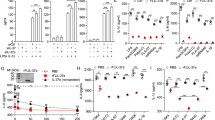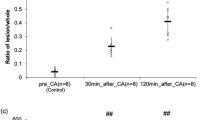Abstract
CYTOKINES are critical in the often fatal cascade of events that cause septic shock1–3. One regulatory system that is likely to be important in controlling inflammatory responses is the neuroendocrine axis. The pituitary, for example, is ideally situated to integrate central and peripheral stimuli4, and initiates the increase in systemic glucocorticoids that accompanies host stress responses6–8. To assess further the contribution of the pituitary to systemic inflammatory processes, we examined the secretory profile of cultured pituitary cells and whole pituitaries in vivo after stimulation with bacterial lipopolysaccharide (LPS). Here we identify macrophage migration inhibitory factor (MIF)9–11 as a major secreted protein released by anterior pituitary cells in response to LPS stimulation. Serum analysis of control, hypophysectomized and T-cell-deficient (nude) mice suggests that pituitary-derived MIF contributes to circulating MIF present in the post-acute phase of endotoxaemia. Recombinant murine MIF greatly enhances lethality when co-injected with LPS and anti-MIF antibody confers full protection against lethal endotoxaemia. We conclude that MIF plays a central role in the toxic response to endotoxaemia and possibly septic shock.
This is a preview of subscription content, access via your institution
Access options
Subscribe to this journal
Receive 51 print issues and online access
$199.00 per year
only $3.90 per issue
Buy this article
- Purchase on Springer Link
- Instant access to full article PDF
Prices may be subject to local taxes which are calculated during checkout
Similar content being viewed by others
Change history
01 November 1995
A Correction to this paper has been published: https://doi.org/10.1038/378419a0
References
Beutler, B. & Cerami, A. Nature 320, 584–588 (1986).
Tracey, K. J. & Lowry, S. F. Adv. Surgery 23, 21–56 (1990).
Dinarello, C. A. J. infect. Dis. 163, 1177–1184 (1991).
Koenig, J. I. et al. Endocrinology 126, 3053–3057 (1990).
Besedovsky, H., Del Rey, A., Sorkin, E. & Dinarello, C. A. Science 233, 652–654 (1986).
Reichlin, S. Williams Textbook of Endocrinology 8th edn. 135–219 (Saunders. Philadelphia, 1992).
Yasuda, N. & Greer, M. A. Endocrinology 102, 947–953 (1978).
Makara, G. B., Stark, E. & Meszaros, T. Endocrinology 88, 412–417 (1971).
Weiser, W. Y. et al. Proc. natn. Acad. Sci. U.S.A. 86, 7522–7526 (1989).
Bloom, B. R. & Bennett, B. Science 153, 80–82 (1966).
David, J. R. Proc. natn. Acad. Sci. U.S.A. 65, 72–77 (1966).
Schumann, R. R. et al. Science 249, 1429–1431 (1990).
Wright, S. D., Ramos, R. A. Tobias, P. S., Ulevich, R. J. & Mathison, J. C. Science 249, 1431–1433 (1990).
Weiser, W. Y., Pozzi, L. M. & David, J. R. J. Immun. 147, 2006–2011 (1991).
Pozzi, L. M. & Weiser, W. Y. Cell. Immun. 145, 372–379 (1992).
Weiser, W. Y., Pozzi, L. M. Titus, R. G. & David, J. R. Proc. natn. Acad. Sci. U.S.A. 89, 8049–8052 (1992).
Cunha, F. Q. et al. J. Immun. 150, 1908–1912 (1993).
Thorner, M. O., Vance, M. L., Horvath, E. & Kovacs, K. Williams Textbook of Endocrinology 8th edn 221–310 (Saunders, Philadelphia, 1992).
Silverstein, R., Turley, B. R., Christoffersen, C. A., Johnson, D. C. & Morrison, D. C. J. exp. Med. 173, 357–365 (1991).
Tracey, K. J., Vlassara, H. & Cerami, A. Lancet I, 1122–1126 (1989).
Fraker, D. L., Stovroff, M. C., Merino, M. J. & Norton, J. A. J. exp. Med. 168, 95–105 (1988).
Kriegler, M. Gene Transfer and Expression: A Laboratory Manual 219–221 (Freeman, New York, 1990).
Boyden, S. V. J. exp. Med. 115 453–466 (1962).
Alonso, S., Minty, A., Bourlet, Y. & Buckingham, M. J. molec. Evol. 23, 11–22 (1986).
Gilliland, G., Perrin, S., Blanchard, K. & Bunn, H. F. Proc. natn. Acad. Sci. U.S.A. 87, 2725–2729 (1990).
Li, B. et al. J. exp. Med. 174, 1259–1262 (1991).
Heumann, D., Baumgartner, J. D., Jacot-Guillarmod, H. & Glauser, M. P. J. infect. Dis. 163, 762–768 (1991).
Author information
Authors and Affiliations
Rights and permissions
About this article
Cite this article
Bernhagen, J., Calandra, T., Mitchell, R. et al. MIF is a pituitary-derived cytokine that potentiates lethal endotoxaemia. Nature 365, 756–759 (1993). https://doi.org/10.1038/365756a0
Received:
Accepted:
Issue Date:
DOI: https://doi.org/10.1038/365756a0
This article is cited by
-
MIF contribution to progressive brain diseases
Journal of Neuroinflammation (2024)
-
CXCR7 as a novel therapeutic target for advanced prostate cancer
Oncogene (2023)
-
Macrophage migration inhibitory factor levels are associated with disease activity and possible complications in membranous nephropathy
Scientific Reports (2022)
-
Individual responsiveness of macrophage migration inhibitory factor predicts long-term cognitive impairment after bacterial meningitis
Acta Neuropathologica Communications (2021)
-
Role of macrophages in fetal development and perinatal disorders
Pediatric Research (2021)
Comments
By submitting a comment you agree to abide by our Terms and Community Guidelines. If you find something abusive or that does not comply with our terms or guidelines please flag it as inappropriate.



